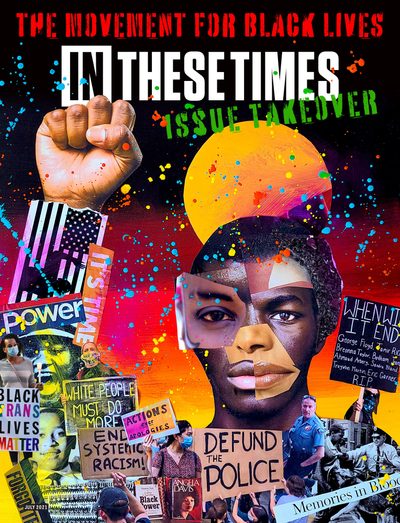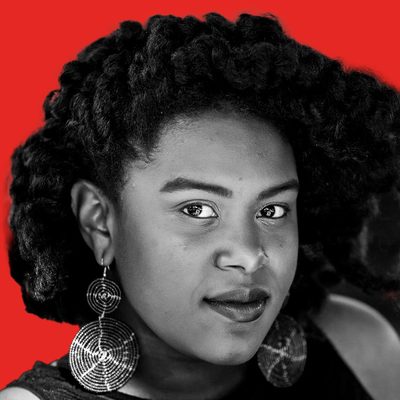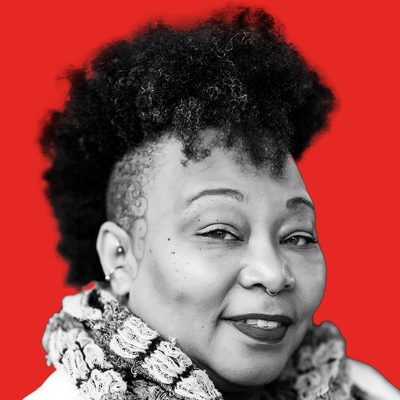Cultural Organizing Gives Us a Roadmap to Liberation
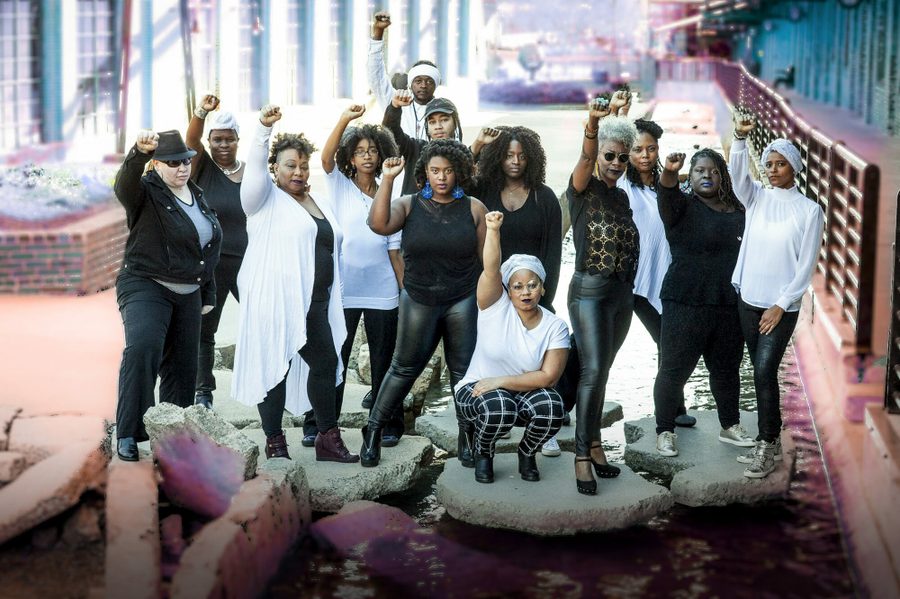
SpiritHouse co-directors Mya Hunter (fifth from left) and Nia Wilson (third from left) with tribe members Heather Lee, Omisade Burney-Scott, Tia Hall, Ebony Noelle Golden, Solanke Olosun-Omimuyegun, Marcella Camara, Paul Newman, Poet Williams, Alexis Pauline Gumbs, Nikki Brown and former member Muffin Hudson at American Tobacco Campus in Durham, N.C., in 2016. The tobacco factory complex was redeveloped in the early 2000s for restaurants, apartments and office space, led to blighting and later gentrifying area neighborhoods where Black families with long ties to work in the warehouses had made their homes. SpiritHouse opened an office here in 2015 to reclaim the space for the ancestors, but left in 2017 because younger Black tribe members faced ongoing harassment by security. PHOTO COURTESY OF SPIRITHOUSE: JOVAN JULIEN
Co-directors of SpiritHouse, a Black women-led tribe in Durham, discuss the “life-saving” rituals and practices of freedom that ground their work towards liberation.
It’s a woman on stage portraying the trauma of going through labor while shackled, the baby stolen away moments after birth, leaving the audience shocked that this practice still exists.
It looks like singing movement songs in city hall chambers during a budget hearing to stop the approval of blighting Black and Brown neighborhoods.
It’s the synchronized slide to the left of hundreds of smiling Black folk on a hot August night as they reclaim a gentrified city street with the electric slide and radical Black joy.
These are a few of the myriad “cultural organizing” practices that manifest through SpiritHouse, a Black women-led, cultural organizing tribe based in Durham, N.C. We say “tribe” because our embodied and liberatory practices preserve customs and rituals necessary to sustain our everyday lives. For the past 22 years, we have been working toward the liberation of Black and oppressed people through cultural organizing.
It is a style of organizing that requires nothing of its practitioners other than to come as fully and authentically as they are. It asks that we set the table with the food our grandmothers made every Sunday, that we sing the songs of welcome we learned from elders, that we honor those who readied the ground before us.
It is a process that demands our organizing strategies not only act in alignment with our political theories of system change, but with our personal cultural selves, in the tradition of Audre Lorde.
Living at the intersection of art, culture and activism, cultural organizing shifts the frame on how we engage in social justice movements. In our opinion, as the directors of SpiritHouse, cultural organizing is gaining in popularity and achieving wins because it is people-centered. It is a lens that values the people and the community as they are, that works alongside them to integrate and leverage their knowledge of themselves into sustainable organizing strategies.
Our own praxis — and what roots our cultural work — is our “CPR methodology”: culture, practice and ritual. These three letters, most often associated with the life-saving technique of cardiopulmonary resuscitation, have come to express that the survival of our community is dependent on identifying, remixing, remastering and finding new ways to do what we have always done to practice the freedom that lives in our DNA. We believe our version of CPR is life-saving, too. Using the tools and technologies of our community, cultural organizing looks like taking city council members through the same exercise we use with high school students to help them viscerally understand the impact of the school-to-prison pipeline. It tastes like cornbread and barbecue at the family cookout while learning about the history of redlining in the South. It is leading Black people countrywide in a daily practice of poetry writing to honor incarcerated and enslaved Black freedom fighters during the Black August month of resistance, and sending those poems to loved ones surviving incarceration.
Cultural organizing has been key to Black organizing since long before SpiritHouse’s founding. It was cultural organizing that mapped routes to freedom in quilts and negro spirituals. We see it in the Black Panthers serving breakfast and pride to children heading off to school, and in Nina Simone singing “To Be Young, Gifted, and Black” with children on Sesame Street. If not for the efforts of Black Southern women, who put their communities on their backs — such as Fannie Lou Hamer, Septima Clark and Pauli Murray — we wouldn’t be here. We are unapologetically Black with hoodies and graphic tees to match.
Cultural organizing is more than an aesthetic to put on or take off. It requires you to know who came before you and how you’re connected in a patchwork quilt of movement families. Cultural organizing entails understanding how people gather in times of joy and sorrow, how we mourn our loved ones, how we carry on legacies.
In CPR, culture provides the road maps of our shared liberation. It’s the utilization of ancestral technologies passed on despite distance and time. It’s how we communicate what lives deep in our bones. The universal head nod, the intricate patterns we cornrow, the baby hairs that are laid with care. It’s the way our hips sway and our feet stomp in time to ancient rhythms and cadences hidden in trap songs.
Practice: As SpiritHouse tribe member Sista Docta Alexis Pauline Gumbs tells us in her book M Archive: After the End of the World, “freedom is not a secret. it’s a practice. it’s contagious. the would-be infiltrators could not get the songs out of their skin. they could not resellout the places where they had internalized freedom.” We practice to embody the values of freedom, accountability and equity. We practice these things now in our families and communities, trusting ourselves to speak our truths and our dreams. We demand these practices be used to create new institutions and systems that honor our lives by ensuring that no one is discarded or left behind.
Ritual lives in the work of the people, powerful and sacred. It requires a deep love and respect for what our ancestors and forebears have done to survive and thrive. For decades we have chanted, told stories and written songs about this. From the moment our ancestors were forced into the bellies of slave ships, our cultures and rituals have been stripped and stolen from us. We became multilingual, learning to code-switch from almost our first breath, choosing carefully which masks to wear and when. We are taught by the people who nurtured us that safety in Blackness is not guaranteed.
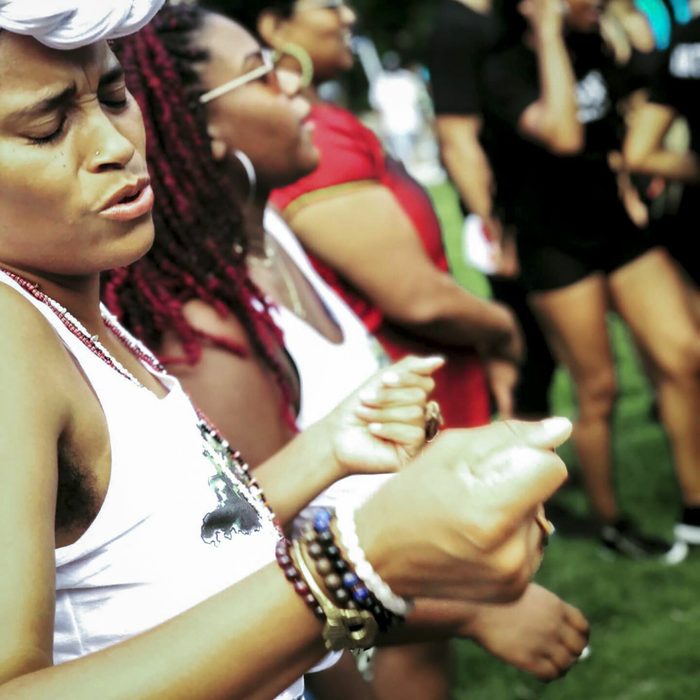
This crucial Black technology is a testament to our survival and genius. But it also speaks to the hate-filled conditioning our people have been forced to eat, digest and pass down. It shows up when we are shamed for the way we speak, for eating fried chicken in public, for living out loud in a place where the written word is more highly regarded than learning through songs, folklore and our oral traditions. It shows up in our conditioning that selfcare is a luxury for the privileged.
Cultural organizing involves the work of carefully removing these digested lies from our own bodies. “SpiritHouse has helped me to know that ‘the work’ is not separate from the forever work of loving and nurturing Black possibility by being myself in community,” Gumbs says. “And love doesn’t react. Love transforms.”
Liberation begins with us. It must settle and live in our bodies, homes and communities. It requires no degrees or certifications, just an unwavering trust in the people.
We’ll leave you with a piece of wisdom passed down from our movement elder and ancestor Nayo Barbara Malcolm Watkins: “You already know all you need to know. It’s in your bones.”
Mya Hunter is a performance artist and documentarian (and daughter, sister, friend, born under the Aquarian sun sign) and serves as co-director of SpiritHouse, where she began her work as a youth organizer more than 10 years ago.
“Mama Nia” Wilson has been part of the SpiritHouse family since 2002 and currently serves as co-director. A story weaver and cultural alchemist, she was raised in Connecticut concrete on saltwater, sand, soul and Campbell’s Pork & Beans.
